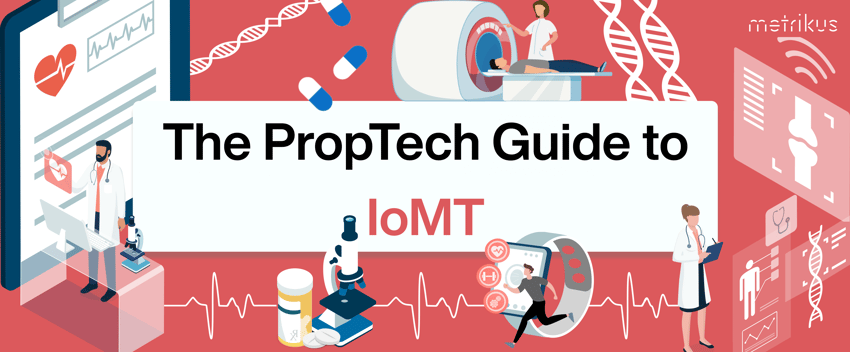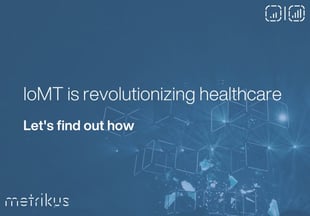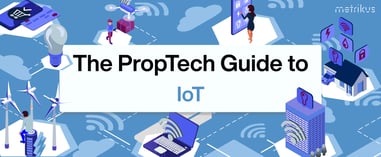What is the Internet of Medical Things? 101 Guide to IoMT
The Internet of Things (IoT) has grown massively in recent years, and it’s starting to have an impact on nearly every aspect of our everyday lives.
It’s a huge part of what we do here at Metrikus, and we are always excited to explore its potential. We’ve already written a guide to IoT in general, but we wanted to go a step further, and delve into one of the fastest growing sectors of the IoT market: the Internet of Medical Things – also known as IoMT.
IoMT revenues reached $24 billion worldwide in 2016, and this number is projected to increase to $135 billion by 2025. Connected technologies can completely transform the healthcare industry, bringing benefits to patients, families, physicians, hospitals and even insurance companies.
What are the main types of IoMT?
What are the key applications of IoMT?
- Assisting diagnosis and treatment
- Virtual assistants
- Robotic surgery
- Drug research
- Drug interaction tracking
- Smart watches
- Smart thermometers
- Connected inhalers
- Heart rate devices
- Automated insulin delivery (AID) systems
- Ingestible sensors
- Mood sensors
- Indoor air quality monitoring
- Occupancy monitoring
- Access control
- Resource tracing
- Smart cleaning
- Legionella monitoring
- Fridge and freezer monitoring
Advantages and disadvantages of IoMT
- What are the advantages of IoMT?
- What are the challenges of IoMT?
- How secure is IoMT?
- How can we increase IoMT security?
IoMT: the basics
What is IoT?
The Internet of Things (IoT) is the global network of physical assets – ‘things’, like sensors and devices – that are connected by the internet. These ‘things’ are used to monitor the world around them and to collect and exchange the resulting data.
The key thing about these assets is that they can ‘talk’ to each other over the internet: this is what makes them ‘smart’. Some ‘things’ collect and send information, some receive information and act upon it, and some can do both. The data that is collected and analysed by IoT can help us make more informed, efficient and meaningful decisions.
- Want to discover some exciting uses of IoT? Check out our blog post: IoT enabled devices that are creating a more equitable world.
How does IoT work?
There are so many types and applications of IoT that it can be confusing to explain exactly how it works. To make things simple, we’ve broken it down into the four key stages that make up a successful IoT deployment.
- Interconnected devices that collect data are deployed (sensors, actuators, monitors, detectors, camera systems etc.)
- Data received from these devices is aggregated and converted from analog to digital form for further data processing
- Once the data is digitised and aggregated, it is pre-processed, standardised and moved to the data centre or Cloud
- The final data is managed and analysed to bring actionable insights and improved decision-making
IoT is a powerful, long-term approach that can bring a huge range of benefits to any individual or organisation. As we continue to connect more and more ‘things’, we can find smart solutions to huge global challenges.
Now we’ve covered the basics of IoT, it’s time to delve into the main topic this guide is dedicated to: IoMT.
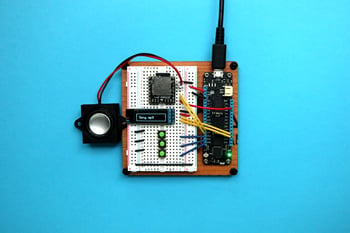
What is IoMT?
The Internet of Medical Things (IoMT) is the use of IoT in the healthcare sector.
It consists of medical devices, platforms and other tools – anything from connected inhalers to wearable biosensors – all of which can have a huge impact on health outcomes.
The rise of IoMT has been driven by a huge increase in the number of connected medical devices that are able to generate, collect, analyse and transmit data. And this growth is showing no signs of slowing: the IoMT market is expected to grow at a compound annual growth rate (CAGR) of 21.0% between 2020 and 2025.
Why has IoMT become so important?
With constant advances in technology, IoMT has shown its potential to redefine healthcare. Goldman Sachs estimates that IoMT will save the US healthcare industry $300 billion annually, mostly through remote patient monitoring and improved medication adherence.
With access to real-time data from connected medical devices, IoMT enables healthcare professionals to reach actionable conclusions more quickly and reliably. Other benefits include:
- Ensuring better care and improving treatment outcomes
- Reducing costs for patients
- Implementing better processes and workflows
- Facilitating improved performance and patient experience
- Enable remote monitoring of patients
Up until now, the general approach to healthcare has mostly been reactive. Going forwards, IoMT, combined with artificial intelligence and machine learning, can help to create a personalised, proactive, preventative and predictive care plan. Pretty exciting, eh?
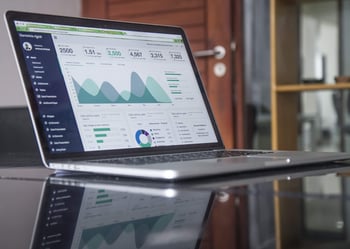
What are the main types of IoMT?
There are loads of different types of IoMT that are doing a great job streamlining the healthcare sector.
- In-home IoMT
- On-body IoMT
- Community IoMT
- In-hospital IoMT
Read on for some more in-depth explanations of what these different types of IoMT entail.
In-home IoMT
In-home IoMT allows people to transmit medical data from their home to other locations, such as their primary care provider or a hospital.
There are loads of ways it can be used, so we’ve picked three examples to make it clear how beneficial it can be.
- Telehealth, the use of communication technologies for remote healthcare services, can allow patients to resolve minor issues by remotely connecting with their doctors.
- Medical devices can transmit metrics like blood pressure or oxygen saturation from a recently discharged patient to their hospital so that it can be reviewed by their doctor. This can help to reduce hospital readmissions by catching issues before they worsen and become more serious.
- Personal emergency response systems (PERS) can track events – such as a fall or heart attack – to automatically call for help.
Remote healthcare has become extremely important during the pandemic, and it seems likely that there will be an increase in in-home IoMT going forwards.
On-body IoMT
On-body IoMT involves wearable medical devices that are connected to remote tracking or monitoring systems.
Unlike in-home IoMT, on-body IoMT can be used outside of the home as people go about their daily lives. It can be split into two key categories: consumer and clinical on-body IoMT devices.
Consumer on-body IoMT devices can be bought by anyone and used to track standard health metrics, and even identify warning signs for more serious health conditions. As well as being great for personal use, data can also be shared with healthcare providers if necessary. A great example of this is smart watches, which have become very popular in recent years.
Clinical on-body IoMT devices are very similar consumer devices but include a much bigger selection of sensor options. For example, glucose sensors can be worn by diabetic patients to alert them to any fluctuations in glucose levels. By sharing data directly with a patient’s doctor, these devices facilitate faster and more accurate treatment.
The advantages of on-body IoMT devices are plenty:
- Alerts can be sent family members/health providers in the case of an emergency
- It is easy to track patients’ adherence to treatment plans
- Healthcare professionals can work with patients proactively
- Physicians can identify the best treatment process for patients and reach the expected outcomes
Take a look at this article to learn more about creating reliable and trusted IoMT devices that put users first.
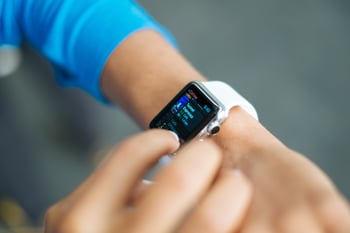
Community IoMT
Community IoMT is the use of IoMT devices throughout a broader geographic area. This could involve:
- Devices used to track patients when they’re in transit in a vehicle
- Systems used by paramedics or first responders to track patients outside of the hospital setting
- Devices to help in the transport of healthcare goods or medical equipment
- Point of care devices that can be used healthcare providers in a non-traditional medical setting like a field hospital
By ensuring accurate data can be collected, assessed, and responded to accordingly, community IoMT has the potential to improve care across a wide range of locations.
In-hospital IoMT
One of the most common and useful places that IoMT devices are used is, unsurprisingly, in hospitals. They increase efficiency, improve outcomes, and provide real-time data on things that can quickly become a matter of life or death.
Common uses of in-hospital IoMT include:
- Tracking staff and patient locations
- Tracking of critical medical equipment
- IoT-enabled hygiene monitoring devices
- Smart inventory control
- Smart cleaning
- Fridge and freezer monitoring
Head to our smart hospital section to learn about these uses and more.
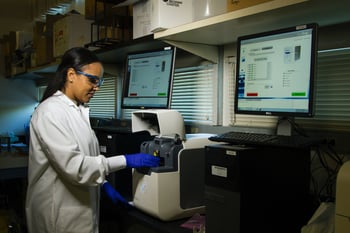
NodeNs have developed some very cool sensors that can reliably measure any objects in a hospital room to the nearest cm.
These sensors can be used to provide accurate real-time data about:
- Room utilisation
- Patient flow optimisation
- Fall detection
- Heart/breathing rates
And the best part: they're plug-and-play and can track users passively without use of wearables.
What are the key applications of IoMT?
As you’re probably starting to realise, the applications of IoMT are many and varied. As time goes by, it’s likely that we will find even more uses for IoT in the healthcare sector.
For the purposes of this guide, we’ve decided to focus on the following broad categories:
- Remote care
- Optimising treatment
- Smart devices
If you have an application of IoMT you’d like to see included, feel free to contact us at marketing@metrikus.io: we love updating these guides with your input.
Remote care
Remote patient monitoring
Remote patient monitoring is probably the most common application of IoMT.
As we’ve already mentioned, IoT devices can automatically collect key health metrics like heart rate, blood pressure, and temperature from patients who are not physically present in a healthcare facility.
This data is then forwarded to a software platform where healthcare professionals and/or patients can view it. Things get even smarter when algorithms are used to analyse the data and recommend treatments or generate alerts so that any necessary action can be taken.
A major challenge with remote patient monitoring is making sure that the highly personal data that IoT devices collect is completely private.
Head to our section about IoMT security to find out more.
Remote elderly care
If elderly people live without a relative or carer nearby, issues can quickly arise if they experience an accident, like a fall, and aren’t able to get assistance, or if they forget to take their medication.
Luckily, IoMT is on hand to offer smart solutions that allow the elderly to maintain a level of independence, while making sure they’re safe in the case of an emergency. With the catchphrase #GrowOldDisgracefully, Alcove is leading the way when it comes to using smart technology to make independent living possible.
There is so much great technology out there, from wearable pendants that can detect a fall, to more extensive home monitoring systems that have the ability to learn your movements and habits. The relevant person can then be alerted if there is a major change in activity or if no motion is detected for an abnormal amount of time.
There are also normal consumer devices that can be a great option for those looking to avoid the cost of stigma of a dedicated solution. For example, smart speakers can remind someone that they need to take their medication or allow them to contact a relative or carer. The Apple Watch even has a feature that can detect a hard fall and alert the emergency services if needed.
Want to learn more about how IoMT can help with elderly care? Check out this article with loads of great examples.
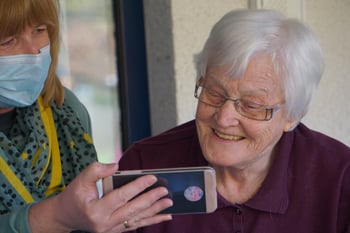
Telemedicine
In 2019, the global telemedicine market was valued at a massive $50 billion, and this is projected to reach $460 billion by 2030.
One of its biggest benefits is that it gives patients the ability to quickly communicate with healthcare providers, saving time by avoiding the need to travel to a clinic or sit in a waiting room. Telemedicine is particularly helpful for homebound patients or those without access to reliable transportation.
There are also significant advantages for healthcare providers, as telehealth allows doctors to diagnose and treat patients without the cost of in-person appointments.
Telemedicine has been thrust into the spotlight in our fight against COVID-19, helping to reduce the risk of transmission between different patients, and between doctors and their patients. Now that we’ve seen its potential, it’s predicted that the market will continue to surge post-COVID.
Virtual hospitals
IoMT is also enabling the creation of dedicated virtual hospitals, where outpatient and long-term care can be delivered remotely by healthcare professionals to patients in their homes. This can be hugely beneficial as it helps to free up vital bed space for patients who need more intensive in-person care.
It also makes it easier to reach patients who can’t leave their homes, including those who are isolating, those who are immunosuppressed, and even those with anxiety or agoraphobia.
Virtual hospitals and wards are being trialled all around the world, and it seems likely that they will become more and more common as time goes on.
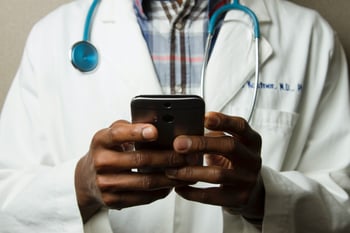
- Australia
The RPA Virtual Hospital (known as rpavirtual) in Sydney, became New South Wales’ first virtual hospital when it opened in February 2020.
When the COVID-19 pandemic hit Australia, it swung into action providing remote care for patients showing symptoms. This included:
- Pulse oximeters – a small, clip-like device normally attached to the finger – to measure oxygen saturation levels and heart rates
- Armpit patches to measure body temperature
The data from these devices could be transmitted via an app on patients’ phones to staff at the virtual hospital. Of the 475 COVID-positive patients monitored by the end of May, only 51 needed to attend the bricks-and-mortar hospital when their conditions had changed. This highlights just how valuable remote wards can be when it comes to reducing the risk of transmission.
- England
In England, the Northampton General NHS Trust carried out a trial in July that involved partnering with Doccla, a virtual hospital care start-up.
Just like the RPA Virtual Hospital, the trial involved patients being equipped with wearable devices to monitor their vital signs. As well as monitoring recovering COVID-19 patients, it also became valuable for those with chronic illnesses.
A survey among the first 40 patients to undergo the trial showed very strong support for the remote patient monitoring model.
- Middle East
The United Arab Emirates’ Ministry of Health and Prevention has established virtual clinics that provide a range of outpatient services: from cardiology and paediatrics, to physiotherapy and mental health services.
By May, the clinics had reportedly cared for more than 15,000 patients, in line with government directives to use smart solutions in the fight against COVID-19.
It’s clear that virtual hospitals have been incredibly useful in the context of the pandemic, and that they have the potential to change the way care is delivered in the long term.
Optimising treatment
Assisting diagnosis and treatment
The diagnosis and treatment of diseases is becoming increasingly intelligent with the rise of new technologies like artificial intelligence and machine learning.
Doctors can give expert advice based on algorithms to improve the accuracy of diagnosis, reduce the incidence of missed diagnosis and misdiagnosis, and allow patients to receive timely and appropriate medical treatment.
For example, in tumor radiotherapy, the patient's progress can be monitored dynamically throughout with the help of smart radiomics. Doctors can optimise the programme, observe disease progress, and avoid the uncertainty that comes with manual operations.
Virtual assistants
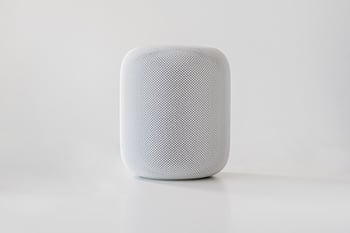
Virtual assistants are not actual entities, but smart algorithms. They rely on big data to obtain information sources, communicate with users through techniques like speech recognition, and then respond according to a user's needs.
Popular examples include Amazon Alexa, Apple's Siri, Google Assistant and Microsoft's Cortana. They can bring a host of benefits to patients, doctors and medical institutions alike:
- Patients
Virtual assistants can convert everyday language into medical terminology, allowing patients to seek the medical service they need more accurately.
- Doctors
Virtual assistants can automatically respond to relevant information based on a patient's basic information, helping doctors to manage patients and coordinate medical procedures more conveniently, saving time and optimising treatment.
- Medical institutions
Virtual assistants can save manpower and material resources, and allow medical institutions to respond to the needs of all parties more efficiently.
By facilitating effective communication between all parties, virtual assistants have the potential to make medical services much smarter and more convenient.
Robotic surgery
Robotic surgery allows doctors to perform complex procedures with more precision, flexibility and control than is possible with conventional methods.
By deploying small IoT devices inside the human body, surgery can become far less invasive, which means:
- Fewer complications e.g. surgical site infection
- Less pain and blood loss
- Quicker recovery
- Smaller and less noticeable scars
There are several well-known robot systems that are already in use, including the da Vinci system, the Sensei X robotic catheter system, and the Flex® Robotic System.
Drug research
IoMT facilitates the automatic screening of the effects of both drugs and targets, which can massively increase the speed of drug development.
Through smart pre-screening, the number of drug molecules that actually need to be screened can be reduced. Artificial intelligence systems then help to collect the latest scientific data in real time and optimise or correct the screening process.
IoMT can also:
- Improve the discovery efficiency of lead compounds
- Predict the possible activity of drug molecules
- Find potential compounds and finally
- Construct a collection of compounds with reasonable properties
Drug interaction tracking
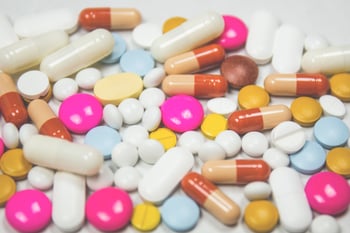
Studies around the world have demonstrated that 3-7% of all hospitalisations are a result of adverse drug reactions (ADRs) and 10-20% of inpatients suffer from drug-related adverse reactions.
Many of these incidents can be avoided by using an IoMT app containing up-to-date drug interaction data, like the possible side effects of the prescribed medicines.
Smart drug interaction apps like those provided by Pediatric Oncall, GenieMD and ZibdyHealth, can assist with a whole range of things, from reminding patients when and how to take prescription medications, to alerting doctors to prevent potential adverse drug interactions.
One of the big benefits is that this information is available wherever, whenever, as long as the patient or doctor has access to the app.
Health insurance
Most of the applications of IoMT we’ve spoken about so far are all about making life easier for patients and doctors, but there are also some very useful ones for health insurance companies.
Health monitoring devices bring transparency between insurers and customers in the underwriting, pricing, claims handling, and risk assessment processes.
Some insurers are starting to offer incentives for patients using and sharing health data generated by IoT devices. By understanding their patients’ routine activities and adherence to treatment plans, insurers can also validate claims or detect fraudulent claims.
When used in the right way, this data can improve efficiency and reduce costs for both parties.
Smart devices
Smart watches
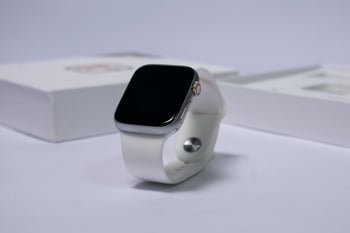
Smart watches weren’t originally designed to be medical devices, but they are increasingly becoming powerful healthcare tools. This is all thanks to a range of applications and features that have been added to them by manufacturers like Apple, Google and Samsung, including:
- Sleep cycle monitoring
- Activity trackers
- Movement reminders
- Guided breathing and meditation exercises
Since the launch of the Series 4, Apple Watches have been able to take an echocardiogram (ECG) using an electrical heart sensor. They can also check for an irregular rhythm that could mean the wearer has atrial fibrillation (AFib), a heart condition that can lead to blood clots, stroke and other heart-related issues.
There are undoubtedly some risks when it comes to integrating medical features into a gadget that’s not specifically designed to be a medical device.
They can be less accurate, cause consumers to over-treat conditions that might not exist or be particularly serious, or even prevent them from seeking medical assessments with the proper equipment. However, if they become more mainstream, these tools could help to discover symptoms early and prevent the onset of more serious conditions.
It’s important for companies to be clear and transparent about the limitations of their devices as well as how data will be used. And as with anything, customers need to make sure they do their research and read the fine print.
Smart thermometers
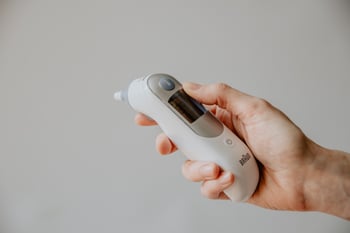
Smart thermometers and the apps that come with them help users determine how to treat illnesses by offering advice based on other factors like age and other symptoms.
This is particularly valuable for parents of young children, who might be unsure how serious an illness is or what symptoms they should be keeping an eye out for.
During the height of the COVID-19 pandemic, Kinsa decided to publish the anonymised, aggregated data from its smart thermometer network across the United States. A map showed clusters of high temperatures that could potentially indicate the outbreak of the virus in a given area.
While COVID-19 is clearly not the only illness that causes a high temperature, Kinsa was able to compare the current data to that collected in previous years in order to distinguish between the clusters caused by COVID-19 and the regular outbreaks of flu and the common cold.
This highlighted an exciting opportunity for IoMT to not only offer data and insights on an individual level, but to show much wider trends and patterns on a regional or national level.
Connected inhalers
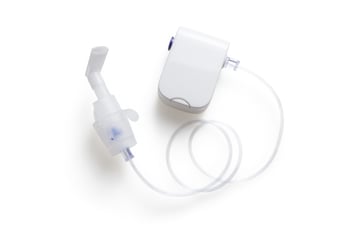
According to the Royal College of Physicians, two in three deaths from asthma could be prevented with measures like personal asthma plans for patients, timely reviews of care and prescription of more suitable medication.
Connected inhalers help patients with respiratory diseases like asthma or chronic obstructive pulmonary disease (COPD) to track their medication use and can send alerts to remind them to take a dose when needed. Other benefits include:
- Improving inhaler technique
- Alerting when an inhaler is left at home
- Ensuring adherence to a medication plan
- Providing allergen forecasts
- Monitoring the frequency of attacks
- Understanding the triggers of attacks
Connected inhalers will also generate usage reports that can be shared with a doctor to optimise treatment plans.
Heart rate devices
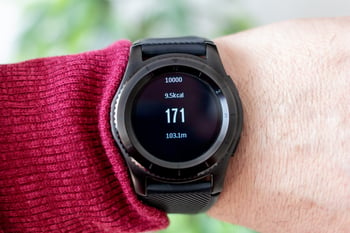
Monitoring heart rates can be pretty challenging, even when patients are in healthcare facilities.
Periodic heart rate checks don’t always catch rapid fluctuations in heart rates, and conventional devices for continuous monitoring mean that patients need to be attached to wired machines constantly, limiting their mobility.
Now, there are plenty of small IoT devices that can be used for heart rate monitoring, allowing patients to move around freely while their heart rate is constantly monitored. Ensuring the accuracy of the results remains challenging, but most devices are at least 90% accurate.
Automated insulin delivery (AID) systems

According to the World Health Organisation, diabetes affects 8.5% of adults worldwide.
Automated insulin delivery (AID) systems (also known as closed-loop insulin delivery systems or Artificial Pancreas systems) can be revolutionary for those suffering from diabetes.
These systems work in conjunction with continuous glucose monitors (CGMs): devices that continuously monitor the body’s blood sugar levels to determine how much insulin is needed.
Instead of having to take a finger prick test to measure their blood glucose levels, the AID system delivers a continuous flow of insulin via the pump. Levels are automatically adjusted based on the glucose levels detected by the CGM, which means that the person experiences far fewer severe highs and lows of blood sugar.
As these devices become more affordable and user-friendly, they have huge potential to prevent more serious health conditions in people with diabetes. This will ease the burden on healthcare systems and allow those with diabetes to live their lives with more confidence and fewer health interventions.
- Want to find out more? Check out this podcast.
Mood sensors

Around 500 million people suffer from mental disorders, making them a concerning global health threat.
Luckily, IoMT is providing us with new capabilities to detect, assess, and care for patients early. ‘Mood-aware’ devices can collect and analyse data to get a better idea of a patient’s mental state.
This includes behavioural data like:
- Location
- Speech features
- Patient activity
And physiological data, including:
- Facial expression
- Heart rate
- Eye movement
- Electrodermal activity
One big issue is interoperability, as this data tends to be scattered across several platforms owned by different vendors. Another is that metrics like these can’t predict depression symptoms or other causes for concern with complete accuracy. But it’s important to remember that traditional in-person mental assessments aren’t always particularly accurate either.
Ingestible sensors

Ingestible sensing capsules are emerging as a critical technology, with the market size expected to reach $1.99 billion by 2024.
They are unsurprisingly very popular with patients, as they offer a much less invasive method than the traditional means of collecting data from inside the body.
Advancements in electronic components have made IoT devices smaller, smarter, and more power efficient. And with widespread access to smartphones connected to the internet, the data produced by ingestible sensors can be readily seen and reviewed online by both patients and doctors.
The outputs can help to reveal the state of gut health and disorders, as well as the impact of food, medical supplements, and environmental changes on the gastrointestinal tract.
Ingestible sensors are also unique in that their passage through the gut gives them access to each individual organ of the gastrointestinal tract. This means that they can gather images and monitor luminal fluid and the contents of each gut segment including electrolytes, enzymes, metabolites, hormones, and the microbial communities.
Cutting through the scientific jargon, this basically means that they’re an easy and non-invasive way to collect loads of data about an individual’s gut health, and they are likely to become more and more popular as time goes on.
Going forwards, there’s an exciting opportunity for IoT to play an important role in boosting mental health care, but we’re at a fairly early stage for now.
- Think any of these applications of IoMT are slightly unusual? Check out our blog post with 10 of the weirdest IoT enabled devices of all time.
Smart healthcare facilities
So far in this guide, we’ve mostly focused on specific uses of IoMT that can help to transform healthcare as we know it. We also wanted to focus on the ways in which IoT can make healthcare facilities themselves smarter, safer, and more efficient.
Some of these solutions are things we can help with here at Metrikus, so check out our smart healthcare use case to find out more.
Indoor air quality monitoring
Those who are unwell are often particularly vulnerable to the effects of polluted indoor environments.
Poor indoor air quality has been linked to lung diseases like asthma, chronic obstructive pulmonary disease (COPD) and lung cancer. Studies have also shown the link between poor air quality and the transmission of airborne viruses like COVID-19, as well as how long they can survive in the air.
By installing indoor air quality sensors, hospitals can monitor key factors in real time, including temperature, humidity, carbon dioxide (CO2), total volatile organic compounds (TVOCs) and particulate matter (PM2.5). And more importantly, a software platform can show what these values should be, and how the current values could be impacting patients.
Smart alerts can notify key members of staff when air quality parameters deviate from their optimal zone, so that steps can be taken to rectify any issues and ensure adequate ventilation at all times.
By monitoring and improving their indoor air quality, healthcare facilities can improve the health of both staff and patients – seems like a no-brainer to us.
- Check out our blog post exploring why indoor air quality is so important.
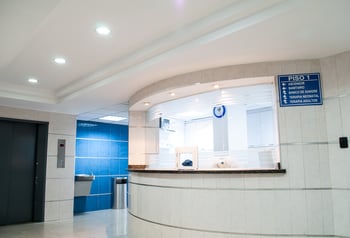
Occupancy monitoring
Hospitals can quickly become overcrowded with patients. This can cause a host of issues, many of which can be life-threatening:
- Shortage of resources
- Patient overflow into other areas of the hospital
- Lack of attention from doctors and other medical personnel
- Faster spread of communicable disease due to the proximity of the patients
By displaying real-time occupancy data, an IoT platform allows staff to understand and control how a healthcare facility is being used.
It’s easy to see how many people are on each floor or in certain areas, and even which specific beds are occupied or vacant. This can be used to direct patients to underutilised floors or empty beds quickly and efficiently.
Occupancy patterns that emerge over time can give a real insight into usage trends across a facility, helping to improve operational efficiency.
Access control
Understanding how doors are being used is essential for building security and regulatory compliance.
By installing IoT sensors on all of the doors in a healthcare facility, it’s possible to understand how many times specific doors are open or closed, and receive alerts when fire doors are left open.
Biometric facial recognition can also allow hospitals to define which people can access the different spaces of the hospital, and at what hours.
This is great for security issues, and can also help to limit the risk of transmission by preventing unauthorised access into sensitive areas. These systems have even evolved to the point of performing facial recognition with a mask on.
Resource tracing
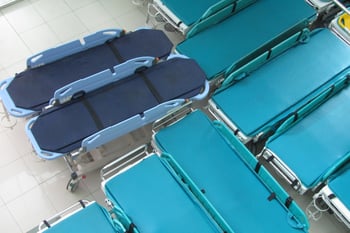
In a fast-paced and high-pressure healthcare environment, the location and status of equipment is often unknown. This means that critical time is wasted tracking down resources or working out whether or not they are available and functioning as they should be.
IoMT makes it easy to track the location and status of critical resources like ventilators and ICU beds, ensuring staff have all the information they need to understand current capacity and improve efficiency.
Hospitals can set thresholds and receive alerts if there are any equipment faults. And this means that engineers can be dispatched quickly with the information they need to fix any equipment on the first visit.
The same technology can also be applied to patients, as smart wristbands can track their location and movement.
Smart cleaning
Cleanliness and hygiene are critical in healthcare facilities as the spread of germs can endanger patients who are already at risk.
Traditionally, areas tend to be cleaned whether they’ve been used or not, and manual schedules are’t always filled in accurately.
IoMT can make things a whole lot easier with sensors that can track cleaning frequencies, and alert the appropriate team when a space is unclean. It’s easy to identify areas that are used most frequently and at what specific times, creating a much smarter and more effective cleaning regime.
Legionella monitoring
Temperature measurement is key when it comes to reducing Legionella risks. Manual testing only provides a snapshot in time, and there are often long periods between tests. It’s also prone to human error and can be difficult to audit.
IoMT helps to improve water safety by enabling continuous and accurate temperature monitoring. Staff can receive automatic alerts for any outlets that are non-compliant to make sure any issues are sorted out immediately.
It’s also a great way to ensure traceability and auditability, as you can access historic data at any time.
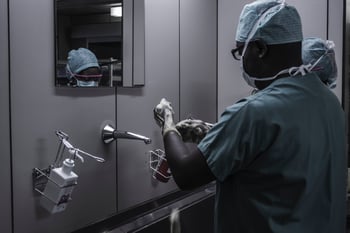
Fridge and freezer monitoring
There are lots of medicines that need to be kept at a specific temperature.
Manual checks not only waste valuable time, but can also be inaccurate due to temperature fluctuations between checks. And with the NHS spending over £7 billion on drugs in hospitals, any unwanted temperature deviations could result in costly wastage.
There are now a range of small, wireless sensors that require no fiddly setup or maintenance that can be placed in fridges and freezers for continuous temperature monitoring. You can then set thresholds and set up alerts to make sure an optimal temperature is maintained all the time.
This helps to save time, improve medicine safety, and even improve energy efficiency by preventing over-cooling. Pretty cool stuff if you ask us (pardon the pun).
Advantages and challenges of IoMT
It’s probably fair to say that a big proportion of this guide has already been spent highlighting the different advantages of using IoT in healthcare.
However, we thought it was worth creating a dedicated section to highlight these again, as we can’t get enough of talking about the benefits of IoMT. We’ve also looked at a few of the challenges associated with the industry, and considered how they can be overcome.
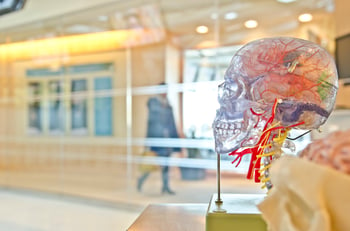
What are the advantages of IoMT?
- Better treatment
Smart devices provide a constant flow of diagnostic data and readily available analytics. This means that healthcare professionals have access to the most relevant data faster and easier, creating more effective and personalised treatment plans.
- Easy access to data
IoMT uses interoperability, machine-to-machine communication, and secure data sharing to keep healthcare providers informed with the most up-to-date patient data.
- Remote care
The ability to monitor patients’ conditions from a distance makes getting the right care easier and cheaper.
- Better decision making
Access to data enables healthcare professionals to make evidence-based, informed decisions. This can shorten recovery time and boost patient treatment adherence.
- Error reduction
The data generated by IoMT devices not only helps with effective decision making but also ensures smooth healthcare operations, saving time and reducing potentially life-threatening errors.
- Faster diagnosis
Continuous patient monitoring and real-time data allows doctors to diagnose diseases at an early stage, or even before the disease develops.
- Cost reduction
IoMT cuts down unnecessary doctor visits, hospital stays and re-admissions. This means significant cost savings and improved allocation and planning.
- Drugs and equipment management
Connected devices make the management of drugs and medical equipment much smarter, safer and more efficient.
- Alerts
In the case of an emergency or life-threatening circumstances, automatic alerts ensure that patients get the care they need.
- Research
IoMT enables us to collect a massive amount of data about different patients and illnesses, and this can be extremely valuable for medical research.
What are the challenges of IoMT?
Like most things in life, IoMT is not without challenges.
In fact, it comes with some pretty unique legal, regulatory, technical and privacy challenges, mostly because the IoMT ecosystem has so many stakeholders, including:
- Medical device providers
- Connectivity providers
- Original equipment manufacturers
- Systems/software providers
- System integrators
- End users
Legal challenges
It’s not always clear who legally owns the data that IoMT devices generate and share.
For example, there might be a scenario where a medical device owned by a city captures data from a patient, stores the data in a third-party cloud application, and then shares the data with a private healthcare organisation.
In this case, who actually owns the data? Is it the city, the patient, the software provider or the healthcare organisation?
There are so many ways in which different parties can use and share the data. The owner might also have the right to destroy the data, which can be complicated in a network where data has been replicated many times.
Regulatory challenges
Due to the sensitivity of medical data, there is lots of regulation surrounding how and where it can be used. And there are detailed specifications about how the technology should be secured.
For example, in the US, the FDA have released comprehensive guidance about the management of cybersecurity in medical devices and in the UK, the NHS have released guidance on protecting medical devices.
However, even with all the regulations and guidance issued, 66% of respondents in a Deloitte study said they believe that the regulatory framework will not catch up with what is possible today for another five years.
There is clearly lots to be done before regulation is completely fit for purpose.
Technical challenges
IoMT infrastructures are often distributed, so it’s vital for different devices and software systems to be able to communicate securely with one another.
However, the protocols and security standards for these types of integrations are constantly changing. This can cause compatibility issues as older systems struggle to keep up to date with new technologies and standards.
Another issue is that device manufacturers haven’t reached a clear agreement about communication protocols and standards.
This means that even if the devices are able to connect, the difference in their communication protocol makes data aggregation more complicated. This slows down the whole process and can massively reduce the scalability of IoMT.
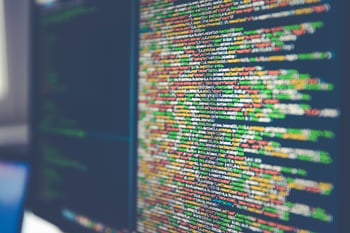
Connectivity challenges
IoMT means that a reliable internet connection is absolutely essential to the wellbeing and safety of healthcare providers and their patients.
There are lots of mission-critical systems that can be negatively impacted by unreliable internet, so maintaining ongoing network connectivity between all the IoMT devices can quickly become a life or death situation.
If IoMT continues to grow, so too will the need to increase the reliability of internet access in remote areas around the world.
How secure is IoMT?
IoMT devices capture and transmit huge amounts of data in real time. And as we’ve mentioned, lots of these devices were not designed with security in mind, lack data protocols and standards, and there is often ambiguity about data ownership.
IoMT data also typically flows through the public internet, exposing it to more security threats than a firewalled private network, and the data is shared among many systems, providing multiple attack vectors.
All of these factors make the data highly susceptible to cybercriminals who can hack into the system and compromise Personal Health Information (PHI) of both patients and doctors. Cybercriminals can misuse a patient’s data to create fake IDs to buy drugs and medical equipment, or even file a fraudulent insurance claim in a patient’s name.
The healthcare industry has been a victim of successful cyber attacks, putting the lives of patients and healthcare personnel at risk.
In 2019, Great Plains Health was the victim of a ransomware attack that caused the hospital to enact its IT downtime procedures. And in 2020, the U.S. Department of Homeland Security’s Cybersecurity and Infrastructure Security Agency released an alert, warning healthcare organisations of serious vulnerabilities found in certain Medtronic MyCareLink medical devices that could potentially impact patient data.
There is clearly a need to increase IoMT security, as unlike other industries, a security breach can quite literally become a matter of losing lives.

How can we increase IoMT security?
There are lots of variables at play when it comes to IoMT security, and there’s no easy way to secure every type of medical device against every type of threat.
However, a basic first step is to make sure you know which medical devices exist on your network, and the different sorts of threats that may impact them.
We’ve highlighted seven key things that should also be taken into consideration.
- Encryption protocols
Technology manufacturers need to use best practice industry guidelines around security, and administrators should use the latest encryption protocols, using unique and complex passwords for access and validating the SSL certificates of remote systems.
- Zero trust network security models
Healthcare facilities should implement a zero trust network security model. This means that communication between devices is controlled by strict access control and authentication, ensuring traffic is always coming from where you think it is.
- Standards
Establishing a unified technical standard is key to achieve maximum compatibility between different devices and platforms. This will help to improve data integrity and remove barriers to information exchange.
- Legislation
Legislation is the most practical way to guarantee the privacy of relevant systems and make smart healthcare more secure.
- Technology upgrades
As the industry grows, there’s an opportunity to accelerate the maturity and stability of IoMT technologies through upgrades. It’s important that professionals from relevant fields work together to clarify the development goals of IoMT.
- Transparency
Technology providers need to demonstrate their commitment to privacy and anonymity when it comes to handling user data. It’s essential that they can show that they are only using it for strictly necessary purposes, and doing everything they can to maintain user privacy.
- Consumer awareness
On the flip side of the coin, consumers should make sure they are aware of the data they are sharing and how it might be used by the company in question.
The future of IoMT
How has COVID-19 impacted IoMT?
The technologies required to support a seamless, anytime, anywhere healthcare have been available for several years. However, until recently, there has been little pressure for consumers, physicians and health systems to adopt these technologies.
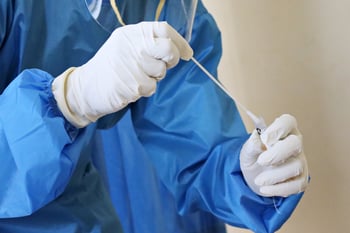
The COVID-19 pandemic has exposed our reliance on in-person care delivery and forced a shift towards digitally enabled remote care. It has also:
- Encouraged health systems and physicians to learn how to provide remote care
- Shown consumers how health technologies can simplify, enhance and personalise their care experiences
- Shattered preconceptions of what it takes to create a digital-first health experience
- Increased openness to adopt smart healthcare technologies in the future
There is now an opportunity for countries around the world to reimagine their healthcare systems as an integrated physical and virtual ecosystem.
Hopefully when we reflect on the pandemic, it will be seen as the catalyst for creating a smarter and more seamless healthcare experience.
What is the future of IoMT?
Perhaps a better question to ask here would be what is the future of healthcare? And our answer to that would have to be – yes, you guessed it! IoMT.
- 83% of patients said they are likely to use telemedicine after COVID-19
- 86% of enterprise healthcare organisations already have an IoT architecture in places
- 54% of executives believe the migration of assets to the cloud will continue to increase post-pandemic
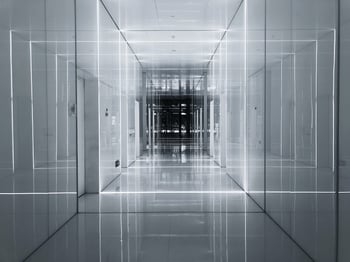
IoMT is an essential part of next-generation healthcare. Connected devices and systems will allow the industry to move from a reactive and ad-hoc model of care, to one that is predictive, preventative and holistic.
And in the coming years, the growth of artificial intelligence and machine learning will only make the potential of IoMT even more exciting. We will hopefully get to a point where we’ve mastered these systems for the treatment of disease and delivery of therapy, and we can begin to use technology to enhance the lives of already healthy individuals.
As IoMT continues to grow, it will pave the way for innovative new technologies, ultimately improving care and saving lives. And whenever we discover new advances in IoMT, we will be sure to add them to this guide, so make sure you bookmark it so that you don’t miss our updates!
Want to stay informed about all things IoT and PropTech? Sign up to our monthly newsletter here.

